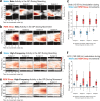Basal ganglia engagement during REM sleep movements in Parkinson's disease
- PMID: 36097027
- PMCID: PMC9468156
- DOI: 10.1038/s41531-022-00382-z
Basal ganglia engagement during REM sleep movements in Parkinson's disease
Abstract
To elucidate the role of the basal ganglia during REM sleep movements in Parkinson's disease (PD) we recorded pallidal neural activity from four PD patients. Unlike desynchronization commonly observed during wakeful movements, beta oscillations (13-35 Hz) synchronized during REM sleep movements; furthermore, high-frequency oscillations (150-350 Hz) synchronized during movement irrespective of sleep-wake states. Our results demonstrate differential engagement of the basal ganglia during REM sleep and awake movements.
© 2022. The Author(s).
Conflict of interest statement
J.E.A., N.H., R.P., M.C.P., and J.L.V. declares no competing non-financial interest but the following competing financial interests. J.E.A. – Consultant for Surgical Information Sciences Inc. N.H. - Consultant and a shareholder for Surgical Information Sciences Inc. R.P. - Consultant for Surgical Information Sciences Inc. M.C.P. - Listed faculty for University of Minnesota Educational Partnership with Medtronic, Inc., Minneapolis, MN, Consultant for: Zimmer Biomet, Synerfues, Inc, NeuroOne, Boston Scientific. Grant/Research support from: Medtronic, Inc., Boston Scientific, Abbott, SynerFuse, Inc., and Fasikl, Inc. J.L.V. - Dr. Vitek serves as a consultant for Medtronic, Boston Scientific and Abbott. He also serves on the Executive Advisory Board for Abbott and is a member of the scientific advisory board for Surgical Information Sciences. He has research support through the National Institutes of Health. All other authors have no competing interest to disclose.
Figures

References
Grants and funding
- P41 EB027061/EB/NIBIB NIH HHS/United States
- P41 EB015894/EB/NIBIB NIH HHS/United States
- UL1 TR002494/TR/NCATS NIH HHS/United States
- P30 NS076408/NS/NINDS NIH HHS/United States
- R01 NS037019/NS/NINDS NIH HHS/United States
- R01 NS117822/NS/NINDS NIH HHS/United States
- R37 NS077657/NS/NINDS NIH HHS/United States
- P50 NS123109/NS/NINDS NIH HHS/United States
- R01 NS058945/NS/NINDS NIH HHS/United States
- R01 NS131371/NS/NINDS NIH HHS/United States
- R01 NS110613/NS/NINDS NIH HHS/United States
- P50 NS098573/NS/NINDS NIH HHS/United States
LinkOut - more resources
Full Text Sources

